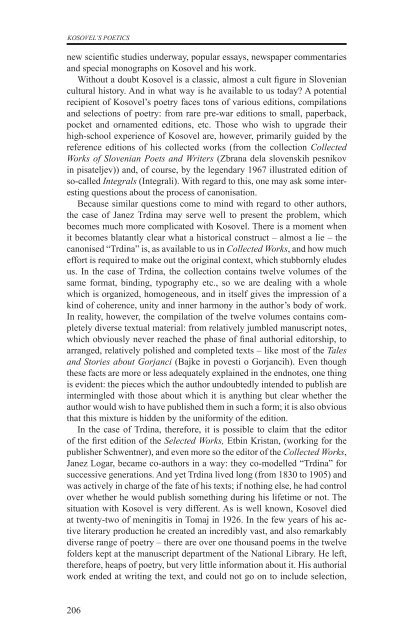razprave (pdf) - Društvo za primerjalno književnost - ZRC SAZU
razprave (pdf) - Društvo za primerjalno književnost - ZRC SAZU
razprave (pdf) - Društvo za primerjalno književnost - ZRC SAZU
- No tags were found...
You also want an ePaper? Increase the reach of your titles
YUMPU automatically turns print PDFs into web optimized ePapers that Google loves.
KOSOVEL’s poeticsnew scientific studies underway, popular essays, newspaper commentariesand special monographs on Kosovel and his work.Without a doubt Kosovel is a classic, almost a cult figure in Sloveniancultural history. And in what way is he available to us today? A potentialrecipient of Kosovel’s poetry faces tons of various editions, compilationsand selections of poetry: from rare pre-war editions to small, paperback,pocket and ornamented editions, etc. Those who wish to upgrade theirhigh-school experience of Kosovel are, however, primarily guided by thereference editions of his collected works (from the collection CollectedWorks of Slovenian Poets and Writers (Zbrana dela slovenskih pesnikovin pisateljev)) and, of course, by the legendary 1967 illustrated edition ofso-called Integrals (Integrali). With regard to this, one may ask some interestingquestions about the process of canonisation.Because similar questions come to mind with regard to other authors,the case of Janez Trdina may serve well to present the problem, whichbecomes much more complicated with Kosovel. There is a moment whenit becomes blatantly clear what a historical construct – almost a lie – thecanonised “Trdina” is, as available to us in Collected Works, and how mucheffort is required to make out the original context, which stubbornly eludesus. In the case of Trdina, the collection contains twelve volumes of thesame format, binding, typography etc., so we are dealing with a wholewhich is organized, homogeneous, and in itself gives the impression of akind of coherence, unity and inner harmony in the author’s body of work.In reality, however, the compilation of the twelve volumes contains completelydiverse textual material: from relatively jumbled manuscript notes,which obviously never reached the phase of final authorial editorship, toarranged, relatively polished and completed texts – like most of the Talesand Stories about Gorjanci (Bajke in povesti o Gorjancih). Even thoughthese facts are more or less adequately explained in the endnotes, one thingis evident: the pieces which the author undoubtedly intended to publish areintermingled with those about which it is anything but clear whether theauthor would wish to have published them in such a form; it is also obviousthat this mixture is hidden by the uniformity of the edition.In the case of Trdina, therefore, it is possible to claim that the editorof the first edition of the Selected Works, Etbin Kristan, (working for thepublisher Schwentner), and even more so the editor of the Collected Works,Janez Logar, became co-authors in a way: they co-modelled “Trdina” forsuccessive generations. And yet Trdina lived long (from 1830 to 1905) andwas actively in charge of the fate of his texts; if nothing else, he had controlover whether he would publish something during his lifetime or not. Thesituation with Kosovel is very different. As is well known, Kosovel diedat twenty-two of meningitis in Tomaj in 1926. In the few years of his activeliterary production he created an incredibly vast, and also remarkablydiverse range of poetry – there are over one thousand poems in the twelvefolders kept at the manuscript department of the National Library. He left,therefore, heaps of poetry, but very little information about it. His authorialwork ended at writing the text, and could not go on to include selection,206
















